iRobot Bundle
How Did iRobot Revolutionize Home Cleaning?
iRobot, a pioneer in consumer robotics, forever changed how we clean with its groundbreaking Roomba. Founded in 1990, this company transformed from a vision of practical robots to a leader in the smart home market. The journey of iRobot is a compelling tale of innovation and strategic adaptation.
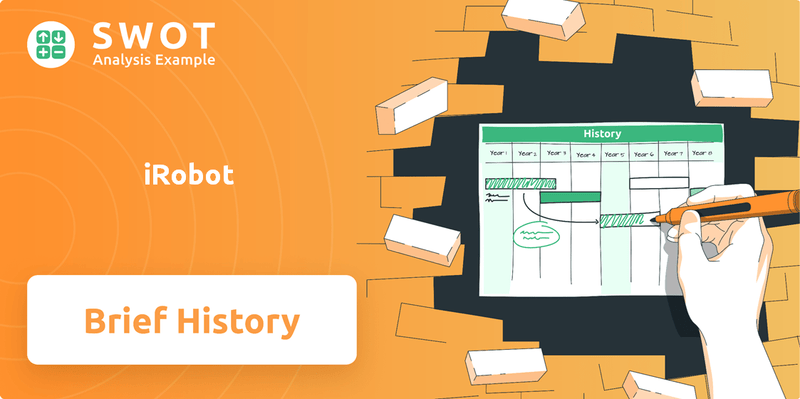
From its humble beginnings, iRobot's iRobot SWOT Analysis shows how it has evolved, initially venturing into military and industrial robotics before dominating the consumer sector. This article delves into the iRobot history, examining its founders' vision and the pivotal moments that shaped its trajectory. Discover the iRobot company timeline, from the release of the Roomba to its current status, and understand iRobot's impact on the robotics landscape.
What is the iRobot Founding Story?
The story of the iRobot company begins on August 21, 1990. It was founded by three roboticists from MIT's Artificial Intelligence Lab: Rodney Brooks, Colin Angle, and Helen Greiner. Their combined expertise in AI, engineering, and computer science laid the foundation for the company's innovative approach to robotics.
The founders saw an opportunity to bring robotics beyond industrial applications. They aimed to create practical, everyday solutions using autonomous robots. Their vision was to develop intelligent robots, reflected in the company's name, iRobot.
Early funding came from grants, including those from NASA and DARPA. This funding supported ambitious R&D projects. The company's initial focus was on government and research contracts. Their first major product was Genghis, a small robot designed for planetary exploration simulation, developed for NASA.
iRobot was founded in 1990 by Rodney Brooks, Colin Angle, and Helen Greiner, all from MIT. The company initially focused on government and research contracts.
- The Genghis robot was among the first projects, designed for planetary exploration simulation.
- Early funding came from NASA and DARPA grants.
- The company's mission was to create intelligent robots for practical use.
- The founders aimed to move robotics beyond industrial applications.
The early years of the iRobot company were marked by a strong emphasis on research and development. The founders leveraged their academic backgrounds to push the boundaries of robotic technology. The company's early projects demonstrated their capabilities in creating mobile, autonomous systems. This laid the groundwork for future innovations, including the development of the Roomba robot vacuum.
The founders' vision was to create robots that could solve real-world problems. Their work in the early 1990s set the stage for iRobot's later success in the consumer market. The company's focus on innovation and practical applications helped it to establish itself as a leader in the robotics industry. This early period was crucial for establishing iRobot's core values and technological expertise.
iRobot SWOT Analysis
- Complete SWOT Breakdown
- Fully Customizable
- Editable in Excel & Word
- Professional Formatting
- Investor-Ready Format
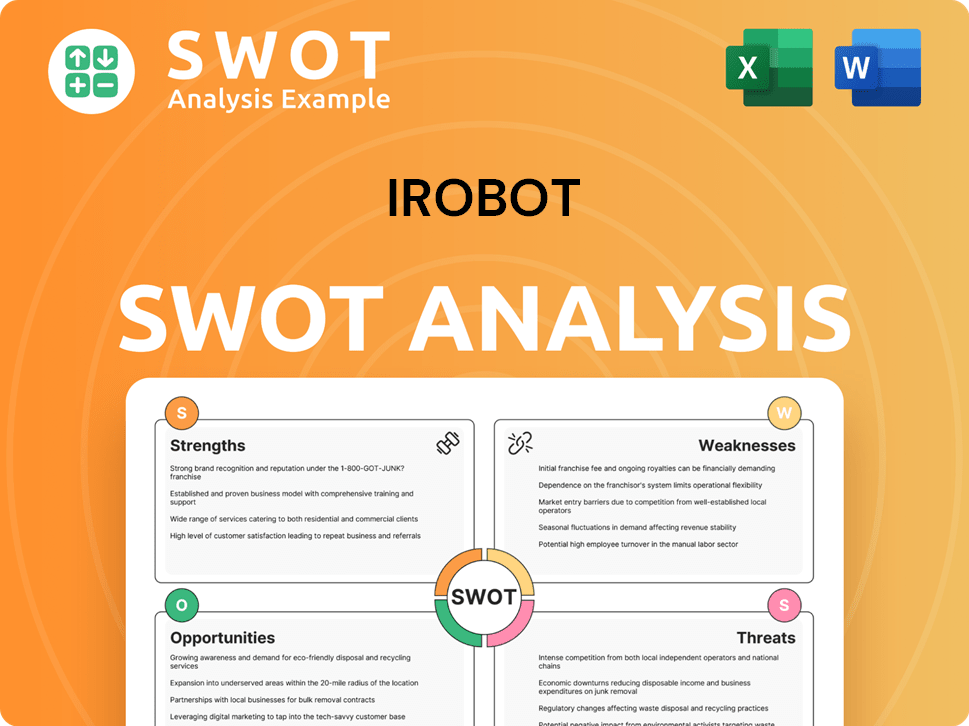
What Drove the Early Growth of iRobot?
The early years of the iRobot company were marked by a dual focus on defense and industrial applications, alongside a pivotal shift towards consumer robotics. Securing contracts with government agencies, particularly for military applications, was a cornerstone of the company's initial growth. This period also saw the introduction of the Roomba, which revolutionized the home cleaning market and set the stage for the company's expansion.
In its early stages, the iRobot company primarily concentrated on defense and industrial robotics. A significant early product was the PackBot, a rugged robot designed for military use, particularly for explosive ordnance disposal (EOD). The PackBot's success, introduced in 2002, significantly contributed to iRobot's revenue and established its reputation. This success allowed the company to expand its engineering teams and invest further in research, contributing to the Owners & Shareholders of iRobot.
The PackBot was widely adopted by the U.S. military. This robot proved instrumental in dangerous situations. The PackBot's durability and reliability quickly made it a valuable asset in the field. The PackBot's success was a key factor in iRobot's early growth and established its expertise in robotics.
The launch of the Roomba robotic vacuum cleaner in September 2002 marked iRobot's entry into the consumer market. The Roomba quickly gained popularity due to its convenience and effectiveness. This success led to significant team expansion and the establishment of dedicated consumer product development facilities. This marked a pivotal shift for the iRobot company.
Following the Roomba's success, iRobot continued to innovate in the home cleaning space, introducing the Scooba floor washing robot in 2005 and the Braava jet mopping robot in 2015. By 2005, iRobot had achieved significant sales milestones, demonstrating the viability of the consumer robotics market. The company went public in 2005, raising capital to further fuel its growth and expand its product lines.
iRobot PESTLE Analysis
- Covers All 6 PESTLE Categories
- No Research Needed – Save Hours of Work
- Built by Experts, Trusted by Consultants
- Instant Download, Ready to Use
- 100% Editable, Fully Customizable
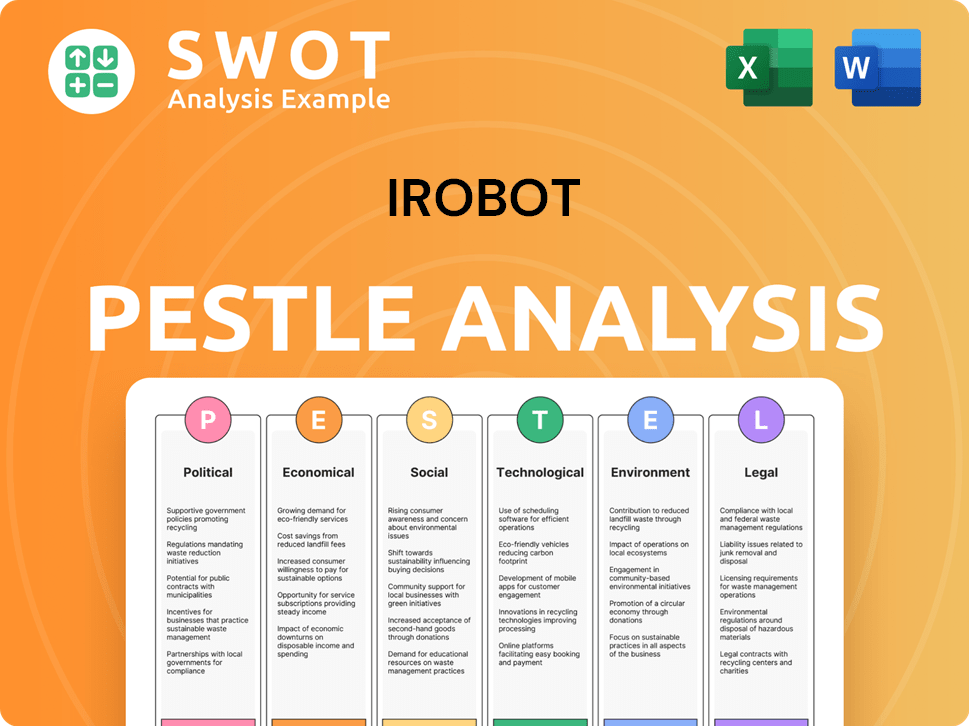
What are the key Milestones in iRobot history?
The iRobot company journey is marked by significant milestones, starting with its founding and the subsequent development of groundbreaking robotic technologies. The launch of the Roomba in 2002 revolutionized the consumer market, establishing a new category of robotic vacuum cleaners. iRobot's success has been driven by continuous innovation and strategic adaptation to market dynamics.
| Year | Milestone |
|---|---|
| 1990 | iRobot is founded by Colin Angle, Helen Greiner, and Rodney Brooks, initially focusing on robotics for defense and exploration. |
| 2002 | The Roomba, iRobot's first consumer product, is launched, marking a significant entry into the home robotics market. |
| 2005 | iRobot goes public, trading on the NASDAQ under the ticker IRBT, raising capital for further expansion and development. |
| 2011 | iRobot introduces the Braava floor mopping robot, expanding its product line to cover multiple home cleaning tasks. |
| 2017 | iRobot acquires the company that makes the Aeris air purifier to diversify its product range. |
| 2024 | The proposed acquisition by Amazon is terminated due to regulatory concerns. |
iRobot has consistently pushed the boundaries of robotics through several key innovations. The introduction of iAdapt Responsive Navigation allowed Roomba to navigate homes intelligently, adapting to different layouts and obstacles. Later, Imprint Smart Mapping enabled robots to learn and map home layouts, enhancing cleaning efficiency and user experience.
This technology enabled Roomba to navigate complex home environments effectively, avoiding obstacles and adapting to different floor plans. This was a key differentiator in the early market for robot vacuums.
Imprint Smart Mapping allowed Roomba to learn and map the layout of a home, enabling more efficient and customized cleaning. This feature improved navigation and allowed users to specify cleaning areas.
iRobot has continuously improved its sensor technology, including cliff sensors to prevent falls and obstacle detection to avoid furniture. These sensors enhance the robot's ability to navigate and clean effectively.
iRobot has integrated its robots with smart home ecosystems, allowing users to control and monitor their devices via mobile apps and voice commands. This integration enhances user convenience and control.
iRobot has developed technologies that allow its robots to automatically adjust to different floor surfaces, such as carpets and hard floors. This ensures optimal cleaning performance across various surfaces.
The company has invested in AI to optimize cleaning paths and efficiency, enhancing its robots' ability to learn and adapt to cleaning environments. This includes features like object recognition and targeted cleaning.
Despite its successes, iRobot has faced several challenges, including intense competition from lower-cost manufacturers, which has impacted market share and pricing. The termination of the Amazon acquisition in early 2024 also presented a significant setback, affecting the company's stock and strategic outlook.
The robot vacuum market has become increasingly competitive, with many companies offering products at lower prices. This has put pressure on iRobot's market share and profit margins.
Some of iRobot's product launches, such as the Mirra pool cleaning robot, have not been successful, leading to financial losses and impacting the company's reputation. These failures have prompted strategic adjustments.
Global supply chain issues, particularly during 2020-2023, have affected iRobot's production and sales, leading to increased costs and delays in product delivery. These disruptions have required the company to adapt quickly.
The failed acquisition by Amazon in January 2024, due to regulatory concerns, impacted iRobot's stock price and strategic planning. This has forced the company to re-evaluate its growth strategies.
Economic downturns can affect consumer spending on discretionary items like robot vacuums, impacting iRobot's sales and revenue. The company must navigate these economic cycles effectively.
Consumer preferences evolve, requiring iRobot to continuously innovate and adapt its products to meet changing demands. This includes features, design, and integration with smart home technologies.
iRobot Business Model Canvas
- Complete 9-Block Business Model Canvas
- Effortlessly Communicate Your Business Strategy
- Investor-Ready BMC Format
- 100% Editable and Customizable
- Clear and Structured Layout
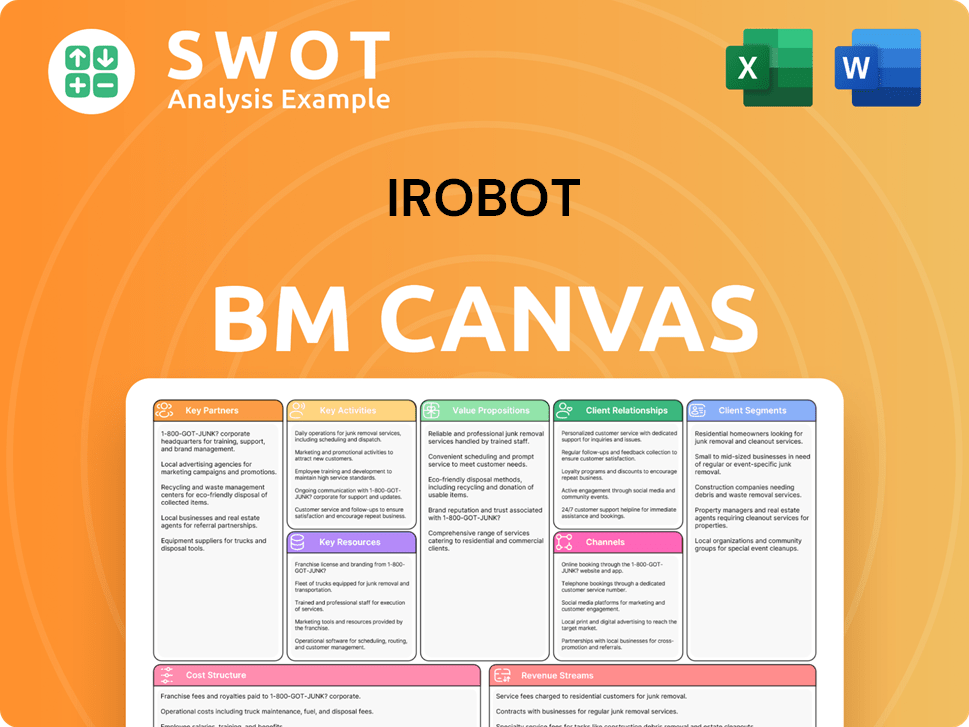
What is the Timeline of Key Events for iRobot?
The iRobot company, a pioneer in the robotics industry, has a rich history marked by innovation and strategic shifts. Founded in 1990, the company initially focused on military and defense applications before transitioning to the consumer market with the launch of the Roomba robot vacuum in 2002. The company's journey includes significant milestones such as its IPO in 2005, the introduction of new product lines like the Scooba floor washing robot, and the strategic decision to focus solely on consumer robotics by selling its Defense & Security business unit in 2016. Despite facing setbacks, including the termination of its acquisition by Amazon in 2024, iRobot continues to evolve, driven by a commitment to innovation and its vision of making practical robots a reality. This evolution is a testament to the company's resilience and its ability to adapt to market dynamics. For a deeper dive into the company's background, consider reading this article about iRobot.
| Year | Key Event |
|---|---|
| 1990 | iRobot is founded by Rodney Brooks, Colin Angle, and Helen Greiner. |
| 1998 | Wins contract to develop PackBot for DARPA. |
| 2002 | Launches the Roomba robotic vacuum cleaner, entering the consumer market. |
| 2005 | iRobot goes public on the NASDAQ stock exchange. |
| 2005 | Introduces the Scooba floor washing robot. |
| 2011 | Sells its 5 millionth home robot. |
| 2015 | Launches the Braava jet mopping robot. |
| 2016 | Sells its Defense & Security business unit to focus solely on consumer robots. |
| 2017 | Introduces Roomba with Imprint Smart Mapping technology. |
| 2019 | Acquires the Aislelabs platform to enhance smart home capabilities. |
| 2022 | Announces agreement to be acquired by Amazon. |
| 2024 | Amazon acquisition of iRobot is terminated due to regulatory hurdles. |
iRobot is expected to integrate more advanced AI and machine learning to enhance its robot vacuum and other products. This includes improved navigation, object recognition, and personalized cleaning capabilities. The company aims to leverage its expertise in robotics to create more efficient and user-friendly devices. These advancements will likely lead to more sophisticated and responsive home robots.
The smart home market is predicted to experience continued growth, with robotic devices playing a crucial role. iRobot is strategically positioned to capitalize on this trend. Expansion into new product categories within the smart home ecosystem, beyond floor care, is a potential long-term goal for the company, allowing it to diversify its offerings.
Following the failed acquisition by Amazon, iRobot is focused on maintaining its market leadership. The company is investing in research and development to stay ahead of competitors. iRobot is committed to innovation, customer experience, and exploring new avenues for robotic assistance in the home. This approach is vital for sustained success.
Despite the recent setback, iRobot remains committed to its founding vision of making practical robots a reality. The company aims to continuously evolve to meet the demands of modern households. iRobot's ability to adapt and innovate will determine its long-term success. The focus remains on creating advanced and user-friendly Roomba models and other robotic solutions.
iRobot Porter's Five Forces Analysis
- Covers All 5 Competitive Forces in Detail
- Structured for Consultants, Students, and Founders
- 100% Editable in Microsoft Word & Excel
- Instant Digital Download – Use Immediately
- Compatible with Mac & PC – Fully Unlocked
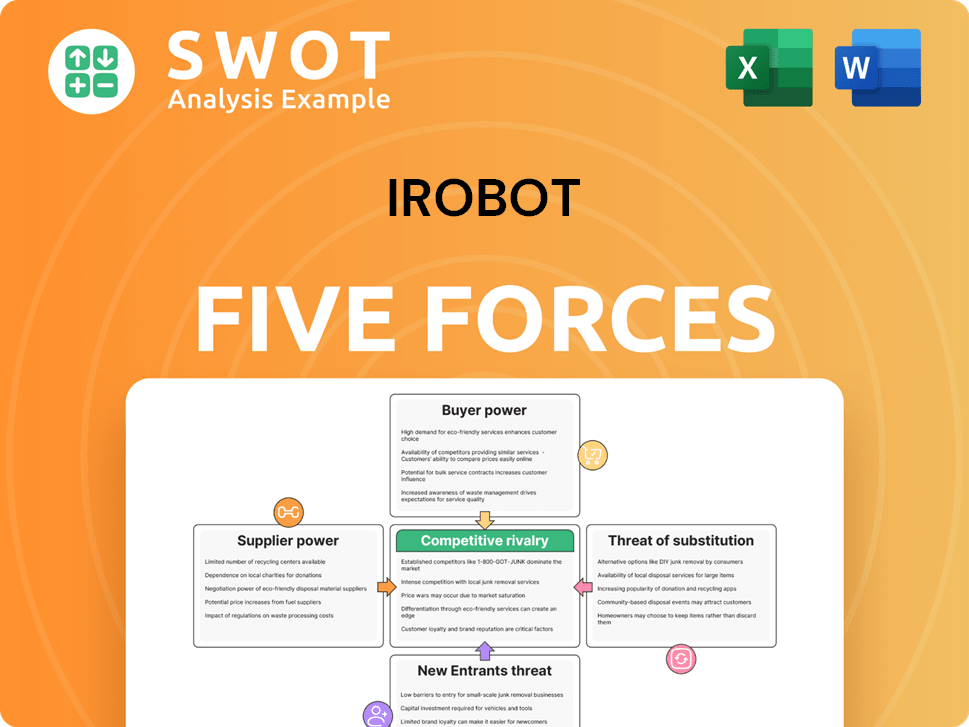
Related Blogs
- What is Competitive Landscape of iRobot Company?
- What is Growth Strategy and Future Prospects of iRobot Company?
- How Does iRobot Company Work?
- What is Sales and Marketing Strategy of iRobot Company?
- What is Brief History of iRobot Company?
- Who Owns iRobot Company?
- What is Customer Demographics and Target Market of iRobot Company?
Disclaimer
All information, articles, and product details provided on this website are for general informational and educational purposes only. We do not claim any ownership over, nor do we intend to infringe upon, any trademarks, copyrights, logos, brand names, or other intellectual property mentioned or depicted on this site. Such intellectual property remains the property of its respective owners, and any references here are made solely for identification or informational purposes, without implying any affiliation, endorsement, or partnership.
We make no representations or warranties, express or implied, regarding the accuracy, completeness, or suitability of any content or products presented. Nothing on this website should be construed as legal, tax, investment, financial, medical, or other professional advice. In addition, no part of this site—including articles or product references—constitutes a solicitation, recommendation, endorsement, advertisement, or offer to buy or sell any securities, franchises, or other financial instruments, particularly in jurisdictions where such activity would be unlawful.
All content is of a general nature and may not address the specific circumstances of any individual or entity. It is not a substitute for professional advice or services. Any actions you take based on the information provided here are strictly at your own risk. You accept full responsibility for any decisions or outcomes arising from your use of this website and agree to release us from any liability in connection with your use of, or reliance upon, the content or products found herein.